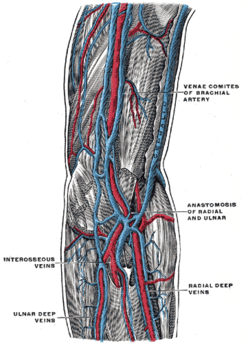Cephalic vein
| Vein: Cephalic vein | |
|---|---|
 | |
| Superficial veins of the upper limb | |
 | |
| The most frequent variations of the veins of the forearm. | |
| Latin | Vena cephalica |
| Gray's | p.661 |
| Source | Dorsal venous network of hand |
| Drains to | Axillary vein and median cubital vein |
| Artery | Deltoid branch of thoracoacromial artery |
In human anatomy, the cephalic vein (or antecubital vein) is a superficial vein of the upper limb.
It communicates with the basilic vein via the median cubital vein at the elbow and is located in the superficial fascia along the anterolateral surface of the biceps brachii muscle.
Superiorly the cephalic vein passes between the deltoid and pectoralis major muscles (deltopectoral groove) and through the deltopectoral triangle, where it empties into the axillary vein.
The cephalic vein is often visible through the skin, and its location in the deltopectoral groove is fairly consistent, making this site a good candidate for venous access. Permanent pacemaker leads are often placed in the cephalic vein in the deltopectoral groove. The vein may be used for intravenous access, and is sometimes referred to as the 'House-man's Friend' because a large bore cannula may be easily placed.
Etymology
Ordinarily the term cephalic refers to anatomy of the head. When Persian physician Ibn Sīnā's Canon was translated into medieval Latin, cephalic was mistakenly chosen to render the Arabic term al-kífal, meaning "outer".[1][2]
Additional images
-
Cross-section through the middle of the forearm.
-

The veins on the dorsum of the hand.
-

The deep veins of the upper extremity.
-

Cross-section through the middle of upper arm
(cephalic vein labeled at upper left)
| Dissection images |
|---|
|
See also
References
- ↑ Diab, Mohammad (1999). Lexicon of orthopaedic etymology. Taylor & Francis. p. 54. ISBN 978-90-5702-597-6.
- ↑ Swenson, Rand. "Etymology of shoulder and arm terms". Dartmouth Medical School: © O'Rahilly 2008. Retrieved 20 April 2011.


